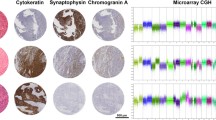Summary
Olfactory neuroblastoma (esthesioneuroblastoma) is a very rare tumour of the olfactory mucosa. Morphological features and cytogenetic studies strongly suggest a neuro-ectodermal origin. Up to now, cytogenetic studies are inconsistent. Some of them have proposed that the tumour belongs to the pPNET family. In the present study we describe genomic imbalances in olfactory neuroblastoma in a 46-year-old woman by using the molecular cytogenetic technique — comparative genomic hybridization (CGH) — in order to define the spectrum of genetic abnormalities in the tumour. The anatomical location and morphological findings were the basis for the diagnosis of esthesioneuroblastoma. Immunohistochemical reactions for NSE, synaptophysin, chromogranin A, HNK-l/Leu-7 and S-100 revealed a characteristic immunophenotype. The CGH analysis showed multiple changes including DNA overrepresentations of chromosomes 4. 8, 11 and 14, partial DNA gains of the long arms of chromosomes 1 and 17, deletions of the entire chromosomes 16, 18. 19 and X, and partial losses of chromosomes 5q and 17p. This study represents an early utilisation of the CGH technique in olfactory neuroblastoma and demonstrates that the tumour carries complex chromosomal aberrations.
Similar content being viewed by others
References
Berger L, Coutard H (1926) L'esthesioneurocytome olfactif. Bull Assoc Franc Etude Cancer 15: 404–414
Bockmühl U, Petersen I, Schwendel A, Dietel M (1996) Genetisches Screening von Kopf-Hals-Karzinomen mittels der Komparativen Genomischen Hybridisierung (CGH). Laryngo-Rhino-Otologie 75: 408–414
Brzoska PM, Levin NA, Fu KK, Kaplan MJ, Singer MI, Gray JW, Christman MF (1995) Frequent novel DNA copy number increase in squamous cell head and neck tumours. Cancer Res 55: 3055–3059
Castaneda VL, Cheah MSC, Saldivar VA, Richmond CM, Parmley RT (1991) Cytogenetic and molecular evaluation of clinically aggressive esthesioneuroblastoma. Am J Ped Hematol Oncol 13: 62–70
Cavazzana AO, Navarro S, Noguera R, Reynolds PC, Triche TJ (1988) Olfactory neuroblastoma is not a neuroblastoma but is related to primitive neuroectodermal tumour (PNET). Prog Clin Biol Res 271: 463–473
Du Mamoir S, Schroeck E, Bentz M, Speicher MR, Joos S, Ried T, Lichter P, Cremer T (1995) Quantitative analysis of comparative genomic hybridization. Cytometry 19: 27–41
Goldsweig HG, Sundaresan N (1990) Chemotherapy of recurrent esthesioneuroblastoma: Case report and review of the literature. Am J Clin Oncol 13: 139–143
Hirose T, Schethauer BW, Lopes MBS, Gerber HA, Altermatt HJ, Harner SG, Van den Berg SR (1990) Olfactory neuroblastoma. Cancer 76: 4–15
Ho-Soon H, Choi MD, Anderson PJ (1985) Immunohistochemical diagnosis of olfactory neuroblastoma. J Neuropathol Exp Neurol 44: 18–31
Jin Y, Mertens F, Arheden K, Mandahl N, Wennerberg J, Dictor M, Heim S, Mitelan F (1995) Karyotypic features of malignant tumours of the nasal cavity and paranasal sinuses. Int J Cancer 60: 637–641
Kallioniemi A, Kallioniemi O-P, Sudar D, Rutovitz D, Gray JW, Waldman F, Pinkel D (1992) Comparative genomic hybridization for molecular cytogenetic analysis of solid tumours. Science 252: 818–821
Kleihues P, Burger PC, Scheithauer BW (1993) Histological typing of tumours of the central nervous system. Springer, Berlin Heidelberg New York Tokyo, pp 25–26
Levin NA, Brzoska P, Gupta N, Minna JD, Gray JW, Christman MF (1994) Identification of frequent novel genetic alterations in small cell lung carcinoma. Cancer Res 54: 5086–5091
Nelson RS, Perlman EJ, Askin FB (1995) Is esthesioneuroblastoma a peripheral neuroectodermal tumour? Hum Pathol 26: 639–641
Pellin A, Boix J, Blesa JR, Noguera R, Carda C, Llombart-Bosch A (1994) EWS/FLI-1 rearrangement in small round cell sarcomas of bone and soft tissue detected by reverse transcriptase polymerase chain reaction amplification. Eur J Cancer 30A: 827–831
Ried T, Baldini A, Rand TC, Ward TC (1992) Simultaneous visualization of seven different DNA probes by in situ hybridization using combinatorial fluorescence and digital imaging microscopy. Proc Natl Acad Sci USA 89: 1388–1392
Ried T, Petersen I, Holtgreve-Grez H, Speicher MR, Schröck E, Du Manoir S, Cremer T (1994) Mapping of multiple DNA gains and losses in primary small cell lung carcinomas by comparative genomic hybridization. Cancer Res 54: 1801–1806
Roth K, Wolf G, Dietel M, Petersen I (1997) Image analysis for Comparative Genomic Hybridization (CGH) by a Windows-based karyotyping program. Anal Quant Cytol Histol: in press
Schröck E, Thiel G, Lozanova T, du Manoir S, Meffert M-C, Jauch A, Speicher MR, Nurnberg P, Vogel S, Janisch W, Donis-Keller H, Ried T, Witkowski R, Cremer T (1994) Comparative genomic hybridization of human malignant gliomas reveals multiple amplification sites and nonrandom chromosomal gains and losses. Am J Pathol 144: 1203–1218
Shanmugaratnam K (1991) Histological typing of tumours of the upper respiratory tract and ear. Springer, Berlin Heidelberg New York Tokyo, pp 68–69
Sorensen PH, Wu JK, Berean KW, Lim FJ, Donn W, Frierson HF, Reynolds CP, Lopez-Terrada D, Triche TJ (1996) Olfactory neuroblastoma is a peripheral primitive neuroectodermal tumour related to Ewing sarcoma. Proc Natl Acad Sci USA 93: 1038–1043
Speicher MR, Howe C, Crotty P, Du Manoir S, Costa J, Ward DC (1995) Comparative genomic hybridization detects novel deletions and amplifications in head and neck squamous cell carcinomas. Cancer Res 55: 1010–1013
Szymas J, Reifenberger G, Wechsler W (1987) Leu-Ml immunoreactivity in the human brain. Naturwissenschaften 74: 188–190
Van Devanter DR, George D, McNutt MA, Vogel A, Luthardt F (1991) Trisomy in primary esthesioneuroblastoma. Cancer Genet Cytogenet 57: 133–136
Vitrey D, Boddaert A, Lecluse Y (1987) Identification immunohistochimique des esthesioneuromes olfactifs, a propos de 16 observations. Ann Pathol 7: 130–136
Whang-Peng J, Freter CE, Knutsen T, Nanfro JJ, Gazdar A (1987) Translocation t(11; 22) in esthesioneuroblastoma. Cancer Genet Cytogenet 29: 155–157
Wolf G, Petersen I, Roth K, Dietel M (1995) Computergestütztes Programm für die molekulare zytogenetische Analyse von soliden Tumoren mittels vergleichender genomischer Hybridisierung (CGH) und digitaler Bildverarbeitung. Verh Dtsch Ges Path 79: 1807
Author information
Authors and Affiliations
Rights and permissions
About this article
Cite this article
Szymas, J., Wolf, G., Kowalczyk, D. et al. Olfactory neuroblastoma: Detection of genomic imbalances by comparative genomic hybridization. Acta neurochir 139, 839–844 (1997). https://doi.org/10.1007/BF01411401
Issue Date:
DOI: https://doi.org/10.1007/BF01411401




